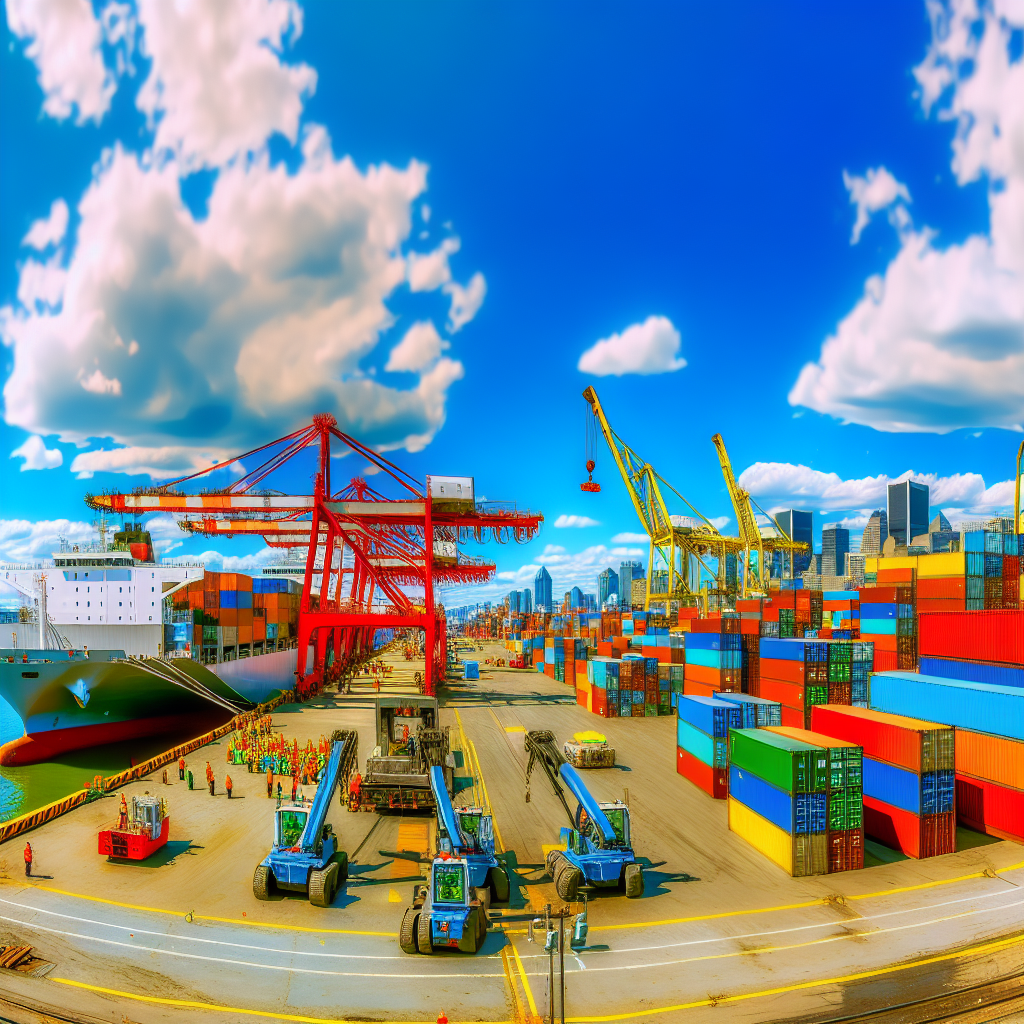The Montreal port expansion stands as a cornerstone of national development, promising to reshape the logistical landscape of Canada and enhance the efficiency of its supply chain infrastructure. As one of the first five nation-building projects approved by Prime Minister Mark Carney, this ambitious initiative is set not only to elevate the Port of Montreal’s capacity by approximately 60% but also to create thousands of jobs across the region.
This expansion is expected to generate an impressive $140 million annually in economic benefits, driving growth throughout Quebec and beyond. By reinforcing vital trade routes and meeting the increasing demand for goods movement, the Montreal port expansion will play a pivotal role in positioning Canada as a leader in global trade.
This moment of transformative change signifies a commitment to empowering Canadian workers and strengthening the nation’s economic foundation, making it a project that is both timely and crucial for the future.
The Significance of the Montreal Port Expansion
This section aims to delve into the critical role that the Montreal port expansion plays in enhancing logistics, fostering economic growth, and impacting local communities positively. Through a comprehensive analysis, we will explore how this pivotal project not only improves trade efficiency but also stimulates job creation and economic activities that benefit the broader Quebec region and beyond.
Economic Impact of the Montreal Port Expansion
The Montreal port expansion is poised to deliver substantial economic benefits that are projected to reshape the local and national economy. Here are some key points highlighting the anticipated impact:
- $140 Million Annual Economic Boost: The expansion is expected to generate approximately $140 million annually, contributing significantly to Quebec’s and Canada’s economic growth.
- Creation of Jobs: Over 8,000 direct and indirect jobs will be created during the construction phase, and more than 1,000 permanent positions will be established once the Contrecœur terminal becomes operational.
- Support for the Economy: A 2023 study by Martin Associates indicated that the Port of Montreal supports over 589,000 jobs and generates $93.5 billion in economic activity, which accounts for 3.5% of Canada’s GDP and 10% of Quebec’s GDP.
- Boost in Trade Volume: The expansion will increase the port’s capacity, allowing it to efficiently handle larger volumes of goods, and thereby support the growing demand for trade routes.
- Investment in Regional Development: The $1 billion Contrecœur expansion project underscores a commitment to substantial investment that enhances infrastructure and promotes sustainable economic development.
- Quotes from Officials: Prime Minister Mark Carney stated, “This project will expand the Port of Montreal’s capacity by approximately 60%, to give Eastern Canada the trading infrastructure it needs to keep goods moving, meet growing demand, and diversify trade routes.”
This transformative recognition emphasizes the project’s role in strengthening Canada’s trading capabilities and bolstering local economies.
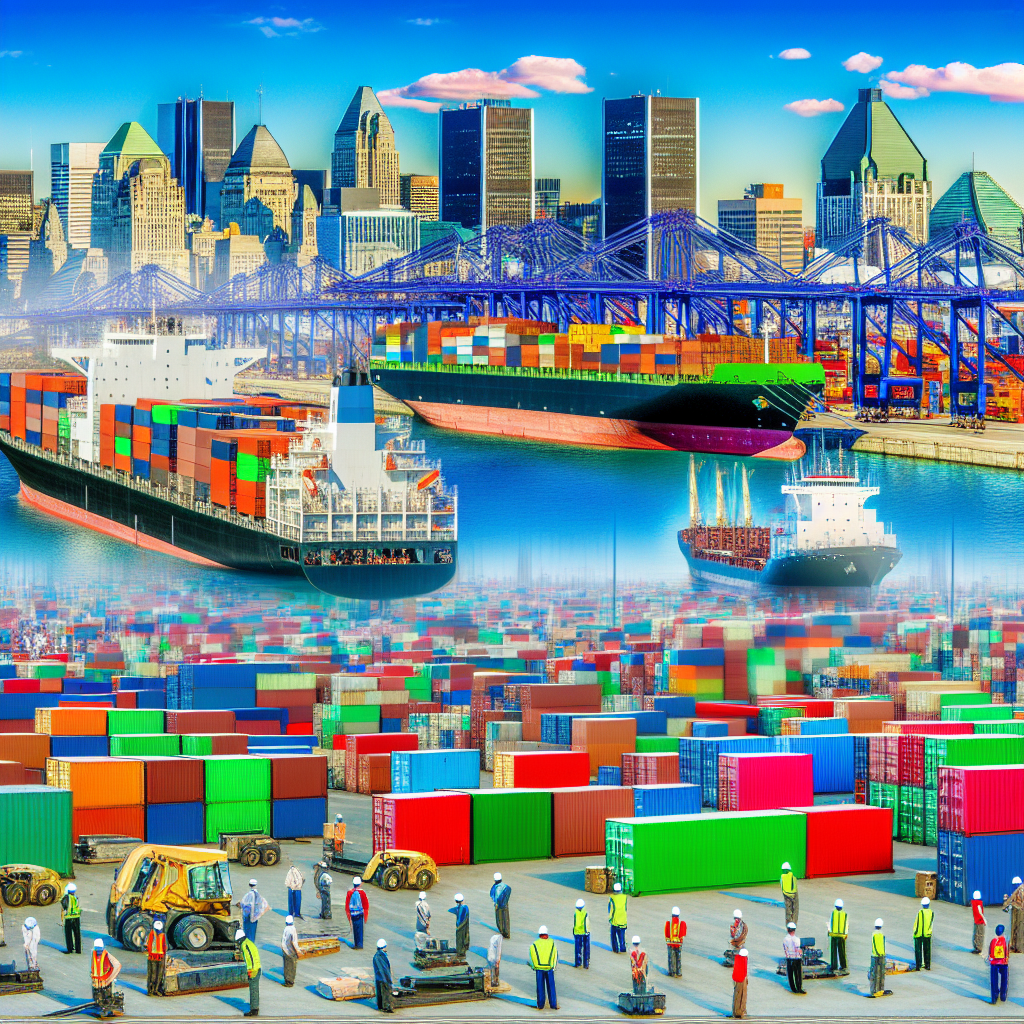
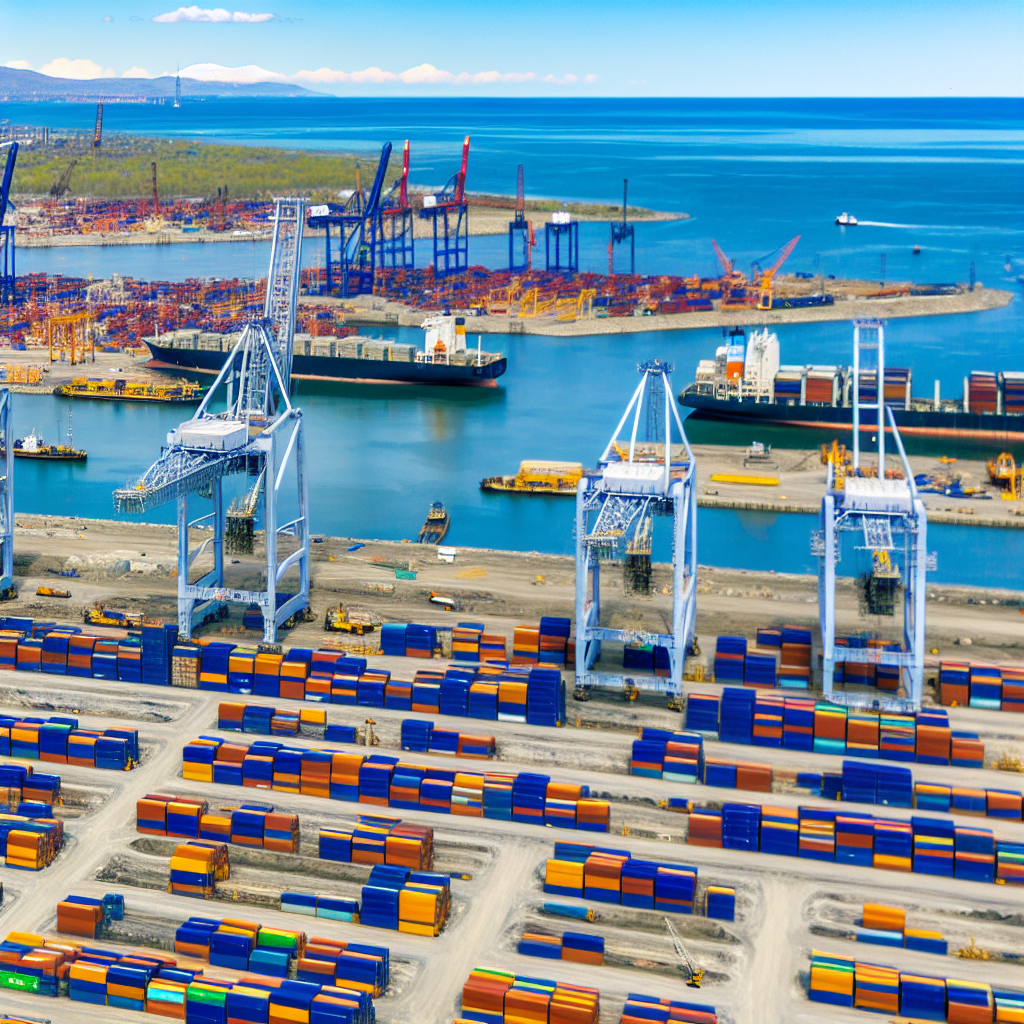
An aerial view of the Montreal Port showcasing expansion construction activities with cranes, shipping containers, and cargo ships in a vibrant and bustling port environment.
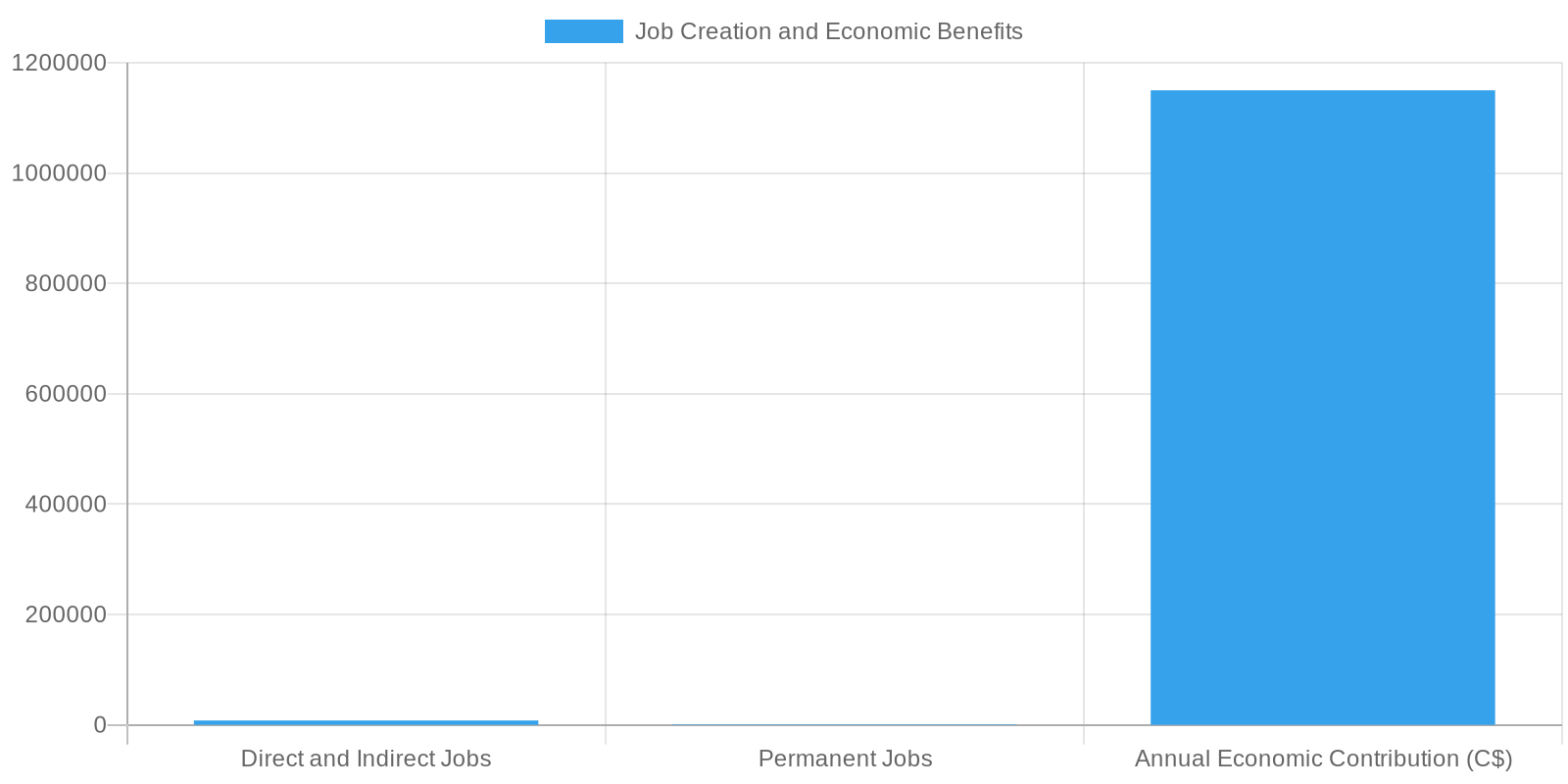
This chart illustrates the projected economic benefits and job creation from the Montreal port expansion over the next five years.
Job Creation and Community Benefits
The Montreal port expansion is not only an infrastructure project; it holds the transformative potential for local communities in Quebec and Eastern Canada through substantial job creation and community benefits.
Job Opportunities Generated
The Contrecœur container terminal, part of the Montreal port expansion, is projected to generate approximately 8,000 jobs during the construction phase and over 1,000 permanent positions once it becomes operational. These jobs will impact various sectors, notably manufacturing and distribution, as local businesses benefit from improved access to international markets and reduced transportation costs.
In 2022 alone, 3.8 million tonnes of goods linked to Ontario transited through the Port of Montreal, generating 5,181 jobs and contributing $208.1 million in tax revenues at the federal, provincial, and local levels. Overall, port operations bolstered 154,774 jobs across the Canadian economy, emphasizing the critical role the port plays in enhancing employment opportunities.
Community Engagement
In addition to economic benefits, the Montreal Port Authority (MPA) is committed to ensuring that the port expansion positively impacts local communities. The MPA plans to implement mutual benefit agreements with local municipalities to address community needs through initiatives such as improving green spaces, youth employment programs, and other community-focused investments. Julie Gascon, President and CEO of the MPA, stated:
“Our intention is clear: the development of the port in Contrecœur must have a positive impact not only on the supply chain that supports our businesses, but also on the local and regional community.”
Environmental Initiatives
The Government of Canada is also investing in Green Shipping Corridor Programs to reduce the environmental impacts of marine activities. This includes projects aimed at electrifying cargo ships and establishing shore power technology to decrease emissions, ensuring cleaner air and water for local residents while supporting job creation.
Conclusion
The expansion of the Port of Montreal is a great example of how strategic investments in infrastructure can lead to job creation while also fostering community and environmental initiatives. By prioritizing local engagement and employing sustainable practices, the project endeavors to enhance the quality of life in Quebec and Eastern Canada while simultaneously strengthening the national economy.
With such comprehensive efforts, the port not only aims to enhance economic growth but also to solidify itself as a central pillar for local communities’ future prosperity.
Implications for Supply Chains
This section will explore how the expansion of the Montreal port is poised to significantly impact supply chains. It will focus on the enhancement of overall efficiency and the diversification of trade routes that come with this critical infrastructure improvement, fostering a more robust logistical ecosystem for Eastern Canada and beyond.
Supply Chain Implications
The expansion of the Montreal port has pivotal implications for supply chains in Eastern Canada. By increasing its capacity by approximately 60%, the Port of Montreal is positioned to significantly enhance logistical efficiency across the region. This enhancement translates into the ability to manage larger volumes of goods, which not only shortens shipping times but also diversifies trade routes, making it an essential hub for both local and international trade.
Increased Capacity and Efficiency
The project is strategically designed to accommodate larger vessels, enabling the port to adapt to evolving global shipping patterns and increased demand for diverse supply sources. This capacity boost is expected to streamline operations, reduce congestion, and ultimately lead to a more responsive and agile supply chain.
As the port upgrades its infrastructure, including crucial improvements in rail capacities and containerized grain handling, these developments will allow for greater integration with national and international trade networks. Enhancing rail services allows for a greater proportion of cargo to be moved efficiently by train, which is not only economically beneficial but also environmentally sustainable.
Enhanced Trade Routes
With the expansion, the Port of Montreal will be better equipped to forge new trade routes and strengthen existing ones. By facilitating timely deliveries and optimizing logistics operations, businesses in Eastern Canada can expect closer ties with major markets in the United States, including access to over 110 million consumers within a 72-hour transit time.
Digital Infrastructure Improvements
The implementation of a new Port Community System Platform will further bolster supply chain efficiency by ensuring real-time connectivity among stakeholders. This digital infrastructure will enhance collaboration and data sharing, providing businesses and logistics providers with the tools to make informed decisions, thereby optimizing the entire supply chain process.
Conclusion
Overall, the Montreal port expansion is set to reshape the supply chain landscape in Eastern Canada, creating a more robust logistical ecosystem. The expected outcomes include not only improved trade efficiency and capacity for larger volumes of goods but also increased economic benefits for the region, characterized by enhanced job creation and regional development. As Canada positions itself as a key player in global trade, the Montreal port expansion will play a pivotal role in sustaining and growing its economic strength.
Economic Benefits vs. Costs of the Montreal Port Expansion
| Economic Benefits | Estimated Costs |
|---|---|
| Annual Economic Contribution: $140 million | Total Project Cost: $1 billion |
| Jobs Created: Over 8,000 during construction | Operational Costs: Ongoing maintenance and staffing for 1,000+ jobs |
| Support for Local Economy: $93.5 billion in economic activity | Investment Risk: Potential delays and increased costs |
| Trade Volume Increase: 60% capacity expansion | Environmental Mitigation Costs: Investments in sustainability initiatives |
| Enhanced Infrastructure: Improved trade routes and logistics efficiency | Long-term Economic Viability: Requires continuous demand for expansion benefits |
| Revenue for Local Governments: Increased tax revenues | Regulatory Compliance Costs: Following environmental and safety regulations |
The table above outlines the various economic benefits projected from the Montreal port expansion against the estimated costs. This juxtaposition is crucial in assessing the overall value and impact of the expansion project on both the economy and the community.
Conclusion
The Montreal port expansion signifies a monumental leap forward for Canada’s trade operations and economic landscape. By enhancing its capacity, the port is set to drive economic growth through significant job creation, with thousands of new positions to support both construction and ongoing operations. This initiative not only emphasizes the importance of community engagement, ensuring that local benefits are prioritized, but also addresses environmental concerns through sustainable practices and habitat protections. Moreover, the project showcases Canada’s commitment to embracing infrastructure improvements that facilitate trade diversity and efficiency in logistics.
Ultimately, the Montreal port expansion positions Canada strategically for future challenges and opportunities in global trade, cementing its role as a key player in an increasingly interconnected market.
Perspectives from Key Stakeholders
As the Montreal port expansion project progresses, it has garnered attention from various stakeholders who underscore its importance for Canada’s economy and trade landscape. Below are some notable quotes that reflect the project’s significance and vision for the future:
-
Mark Carney, Prime Minister of Canada:
“Export terminals and ports are projects of national interest that provide the infrastructure needed to diversify trade, open new markets, and reduce costs for Canadian businesses.” [pm.gc.ca]
This statement highlights the role of infrastructure in advancing trade opportunities for Canada.
-
Mark Carney, Prime Minister:
“Our government is in the process of unleashing half a trillion dollars of investment in energy infrastructure, port infrastructure, particularly intelligence infrastructure, as well, with AI.” [maritimemag.com]
This remark emphasizes the commitment to investing in crucial infrastructure, including the Montreal port, to support economic growth.
-
Dominic LeBlanc, Minister of Intergovernmental Affairs:
“One of the reasons why this project is so important for the government of Canada is that it is a mix of private and public investment that will make a significant contribution to the GDP of the country.” [ttnews.com]
This analysis points out the collaborative nature of funding and its expected impact on economic indicators.
-
Martin Imbleau, President and CEO of the Montreal Port Authority:
“We are developing this project not only for years to come but for decades to come.” [port-montreal.com]
This insight showcases the long-term vision associated with the port expansion.
-
Julie Gascon, President and CEO of the Montreal Port Authority:
“This step allows us to meet the conditions required to move forward with a project that positions Quebec and Canada more strongly to diversify international trade.” [maritimemag.com]
This quote highlights how the expansion supports broader trade diversification goals.
These quotes encapsulate the strategic vision and collaborative effort surrounding the Montreal port expansion, emphasizing its potential to reshape Canada’s economic landscape and enhance its trade capabilities.
Recent Developments in Canadian Port Infrastructure and Economic Impact
- The Canadian government identifies five major infrastructure projects for expedited approval, including the Montreal port expansion, under Prime Minister Mark Carney.
- The Port of Montreal supports approximately 600,000 jobs and handles significant cargo volumes, underscoring its economic importance.
- Labor disputes highlighted the impact of port operations on economic activity, emphasizing the need for effective labor relations to sustain operations.
- The Hamilton-Oshawa Port Authority has successfully diversified cargo shipments, evidencing the significant economic activities associated with ports.
- BMO’s CEO emphasizes the importance of clarity in trade policies to attract investment in infrastructure projects, highlighting the financial sector’s role in supporting such developments.
These developments underscore the critical role of port infrastructure in Canada’s economic landscape, highlighting the importance of strategic investments and effective labor relations in sustaining and enhancing the nation’s trade capabilities.
Environmental Impacts of the Montreal Port Expansion
The Montreal port expansion carries not only economic advantages but also raises significant environmental concerns that merit thorough examination. As this project progresses, various studies and proposals are in place to mitigate potential environmental impacts, ensuring that the expansion does not detrimentally affect local ecosystems.
Habitat Disruption Concerns
One of the primary environmental concerns associated with the Port of Montreal’s expansion is the potential threat to the habitat of the endangered copper redhorse fish, native to Quebec. Environmental groups have voiced concerns about possible damage to the species’ feeding grounds in the St. Lawrence River. To address these concerns, the Montreal Port Authority (MPA) has put forth a variety of offsetting measures. These initiatives include:
- Creating New Fish and Bird Habitats: Establishing dedicated areas to support wildlife.
- Restoring Wetlands: Implementing restoration projects to rejuvenate existing wetlands that may be impacted.
- Monitoring Populations: Continuous assessment of the copper redhorse and other sensitive species to gauge the health of the local ecosystem. [source]
Community Engagement Initiatives
The MPA emphasizes its commitment to working with local communities through mutual benefit agreements. These agreements aim to facilitate:
- Green Space Improvements: Enhancing parks and recreational areas for community use.
- Youth Employment Programs: Targeting job creation specifically for young individuals in the region to foster community development.
The blend of economic and ecological strategies is crucial to ensuring that the project benefits both the economy and local residents. [source]
Comparative Case Studies of Port Expansions
Examinations of other ports undergoing expansions reveal various strategies to mitigate environmental impacts while fostering economic growth. Here are notable examples:
- San Pedro Bay Ports Clean Air Action Plan: This initiative led to significant reductions in air pollutants as the Ports of Los Angeles and Long Beach implemented voluntary programs, improving air quality for nearby communities. [source]
- New York/New Jersey Harbor Deepening Project: This project utilized measures that successfully prevented 2,000 tons of nitrogen oxide emissions during its development, enhancing air quality in the metropolitan area. [source]
- Port of Rotterdam’s Green Hydrogen Initiatives: With substantial investment in renewable energy, the port aims to diminish its carbon footprint through innovations like green hydrogen production. [source]
- Roberts Bank Terminal 2 Project: This ongoing evaluation project includes ecosystem modeling to assess the potential impacts on local food webs and inform mitigation strategies. [source]
- Port of Los Angeles: Shore Power Implementation: This technology allows ships to connect to the local electrical grid while docked, significantly abating emissions. [source]
Conclusion
The expansion of the Montreal port, while fostering notable economic growth, necessitates scrupulous attention to its environmental implications. Continuous dialogue with stakeholders, community engagement, and proactive mitigation measures are essential to balancing growth with ecological preservation. The ongoing efforts of the Montreal Port Authority to implement habitat protection strategies reflect a growing awareness that infrastructure projects can and should harmonize development with environmental stewardship.
Key Benefits of the Montreal Port Expansion
- Increased Capacity: The project will expand the Port of Montreal’s capacity by approximately 60%.
- Economic Contribution: Expected to generate around $140 million annually in economic benefits.
- Job Creation: Projected creation of more than 8,000 jobs during construction and over 1,000 permanent positions.
- Enhanced Trade Efficiency: The expansion will streamline trade operations and reduce shipping times.
Job Creation Focus
- Short-Term Jobs: An estimated 8,000 jobs will be created during the construction phase, predominantly in manufacturing and logistics sectors.
- Long-Term Positions: 1,000+ permanent roles will support ongoing operations, enhancing regional employment.
- Broader Employment Impact: Through improved access to international markets, local businesses can expect growth and sustainability.
Economic Impact Overview
- Support for Local Economy: The Port significantly contributes to Quebec’s economy, supporting 589,000 jobs and generating $93.5 billion in economic activity.
- Robust Infrastructure Investment: The $1 billion Contrecœur expansion emphasizes the commitment to state-of-the-art infrastructure.
- Diversification of Trade Routes: The expansion offers a vital opportunity for diversifying trade routes with greater efficiency.
This structured outline not only highlights the key points related to the project but also enhances the article’s overall readability, allowing readers to quickly grasp essential information.
Economic Impact of the Montreal Port Expansion
The Montreal port expansion is poised to deliver substantial economic benefits that are projected to reshape the local and national economy. Here are some key points highlighting the anticipated impact:
- $140 Million Annual Economic Boost: The expansion is expected to generate approximately $140 million annually, contributing significantly to Quebec’s and Canada’s economic growth.
- Creation of Jobs: Over 8,000 direct and indirect jobs will be created during the construction phase, and more than 1,000 permanent positions will be established once the Contrecœur terminal becomes operational.
- Support for the Economy: A 2023 study by Martin Associates indicated that the Port of Montreal supports over 589,000 jobs and generates $93.5 billion in economic activity, which accounts for 3.5% of Canada’s GDP and 10% of Quebec’s GDP.
- Boost in Trade Volume: The expansion will increase the port’s capacity, allowing it to efficiently handle larger volumes of goods, and thereby support the growing demand for trade routes.
- Investment in Regional Development: The $1 billion Contrecœur expansion project underscores a commitment to substantial investment that enhances infrastructure and promotes sustainable economic development.
- Quotes from Officials: Prime Minister Mark Carney stated, “This project will expand the Port of Montreal’s capacity by approximately 60%, to give Eastern Canada the trading infrastructure it needs to keep goods moving, meet growing demand, and diversify trade routes.”
Local Stakeholder Perspectives
Jean-François Lévesque, CEO of the South Shore Chamber of Commerce and Industry (CCIRS), emphasized the strategic importance of the Contrecœur expansion:
“We firmly believe that the Port of Montreal in Contrecœur is a strategic infrastructure for the region, and its expansion is a crucial step for our economic development, as several future-oriented sectors, such as the food and battery industries, will benefit from an international connection.”
Government Support
The Canadian government has also recognized the significance of enhancing supply chain infrastructure. In October 2024, Transport Canada announced up to $38 million in funding for seven projects under the National Trade Corridors Fund, including initiatives to increase export capacity for Canadian containerized grains and develop industrial-port zones. These investments aim to reduce capacity constraints and bottlenecks, facilitating quicker movement of goods and supporting economic growth in Quebec and regions along the St. Lawrence River.
Chart: Projected Job Creation from Montreal Port Expansion
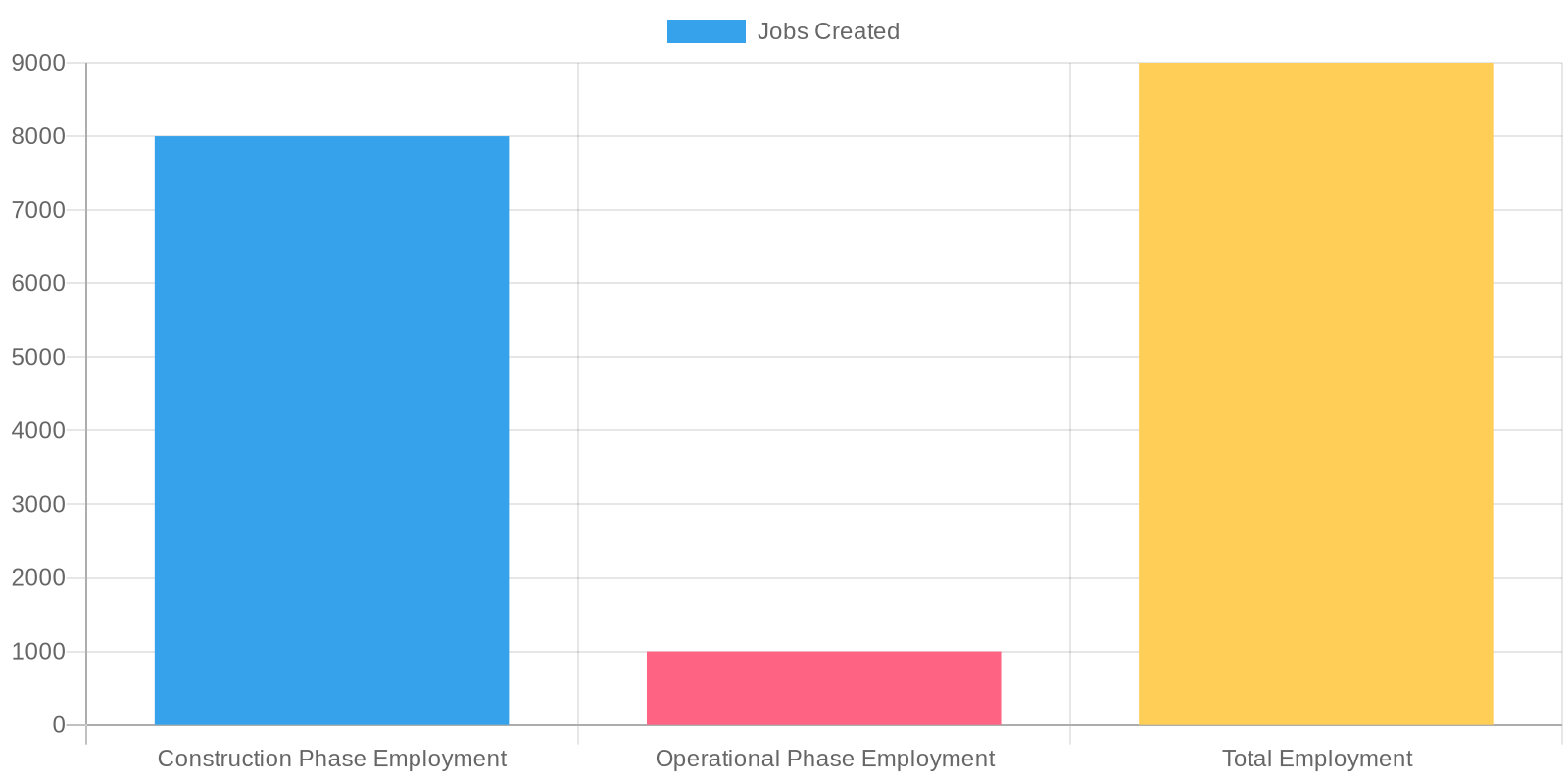
This chart illustrates the projected job creation during different phases of the Port of Montreal expansion.
- Construction Phase Employment: Over 8,000 jobs expected during construction.
- Operational Phase Employment: 1,000 permanent jobs once operational.
- Total Employment Impact: A total of approximately 9,000 jobs associated with the expansion initiative.
These insights from industry experts and local stakeholders collectively highlight the anticipated positive impacts of the Port of Montreal’s expansion on supply chains, job creation, and economic development.
Montreal Port Expansion and Its Impact on Supply Chain Infrastructure
Introduction
The Montreal port expansion stands as a cornerstone of national development, promising to reshape the logistical landscape of Canada and enhance the efficiency of its supply chain infrastructure. As one of the first five nation-building projects approved by Prime Minister Mark Carney, this ambitious initiative is set not only to elevate the Port of Montreal’s capacity by approximately 60% but also to create thousands of jobs across the region. This expansion is expected to generate an impressive $140 million annually in economic benefits, driving growth throughout Quebec and beyond. By reinforcing vital trade routes and meeting the increasing demand for goods movement, the Montreal port expansion will play a pivotal role in positioning Canada as a leader in global trade. This moment of transformative change signifies a commitment to empowering Canadian workers and strengthening the nation’s economic foundation, making it a project that is both timely and crucial for the future.
The Significance of the Montreal Port Expansion
This section aims to delve into the critical role that the Montreal port expansion plays in enhancing logistics, fostering economic growth, and impacting local communities positively. Through a comprehensive analysis, we will explore how this pivotal project not only improves trade efficiency but also stimulates job creation and economic activities that benefit the broader Quebec region and beyond.
Economic Impact of the Montreal Port Expansion
The Montreal port expansion is poised to deliver substantial economic benefits that are projected to reshape the local and national economy. Here are some key points highlighting the anticipated impact:
- $140 Million Annual Economic Boost: The expansion is expected to generate approximately $140 million annually, contributing significantly to Quebec’s and Canada’s economic growth.
- Creation of Jobs: Over 8,000 direct and indirect jobs will be created during the construction phase, and more than 1,000 permanent positions will be established once the Contrecœur terminal becomes operational.
- Support for the Economy: A 2023 study by Martin Associates indicated that the Port of Montreal supports over 589,000 jobs and generates $93.5 billion in economic activity, which accounts for 3.5% of Canada’s GDP and 10% of Quebec’s GDP.
- Boost in Trade Volume: The expansion will increase the port’s capacity, allowing it to efficiently handle larger volumes of goods, and thereby support the growing demand for trade routes.
- Investment in Regional Development: The $1 billion Contrecœur expansion project underscores a commitment to substantial investment that enhances infrastructure and promotes sustainable economic development.
- Quotes from Officials: Prime Minister Mark Carney stated, “This project will expand the Port of Montreal’s capacity by approximately 60%, to give Eastern Canada the trading infrastructure it needs to keep goods moving, meet growing demand, and diversify trade routes.”
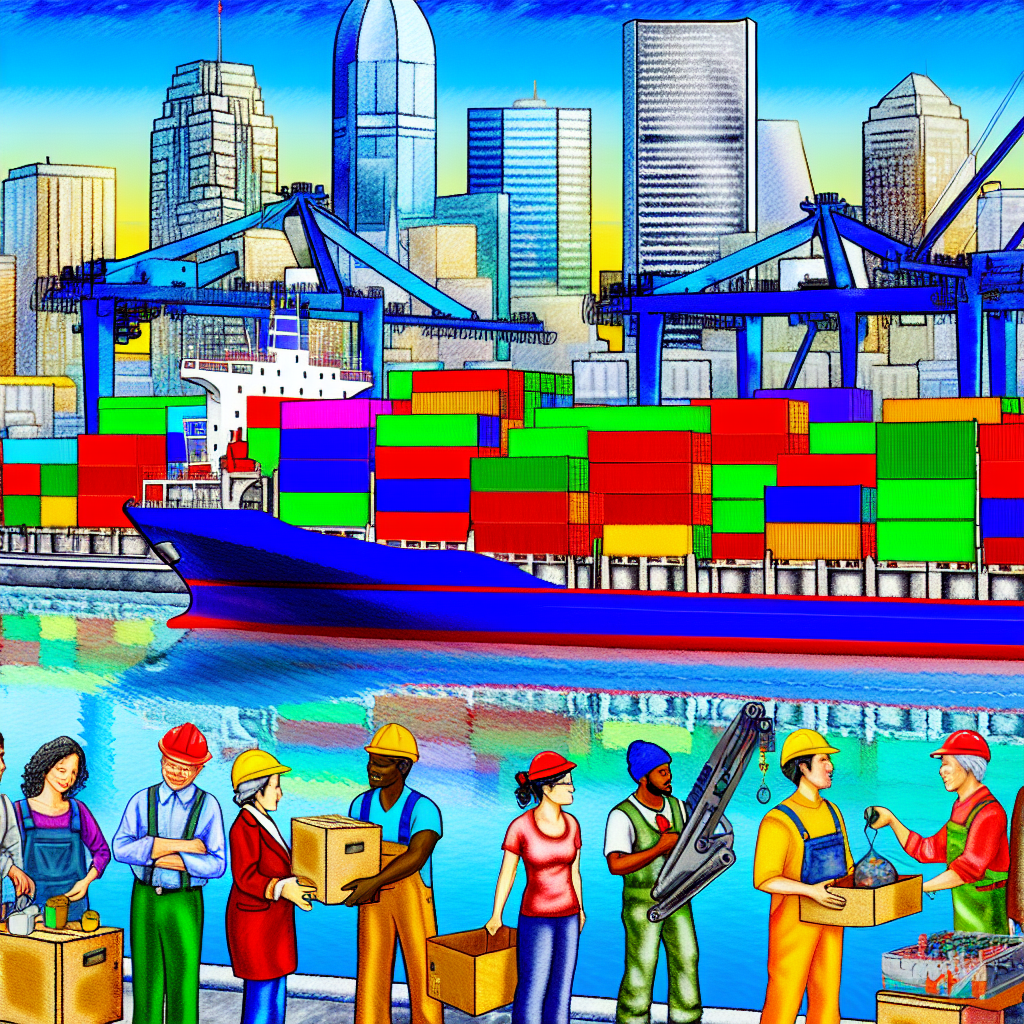
An aerial view of the Montreal Port showcasing expansion construction activities with cranes, shipping containers, and cargo ships in a vibrant and bustling port environment.
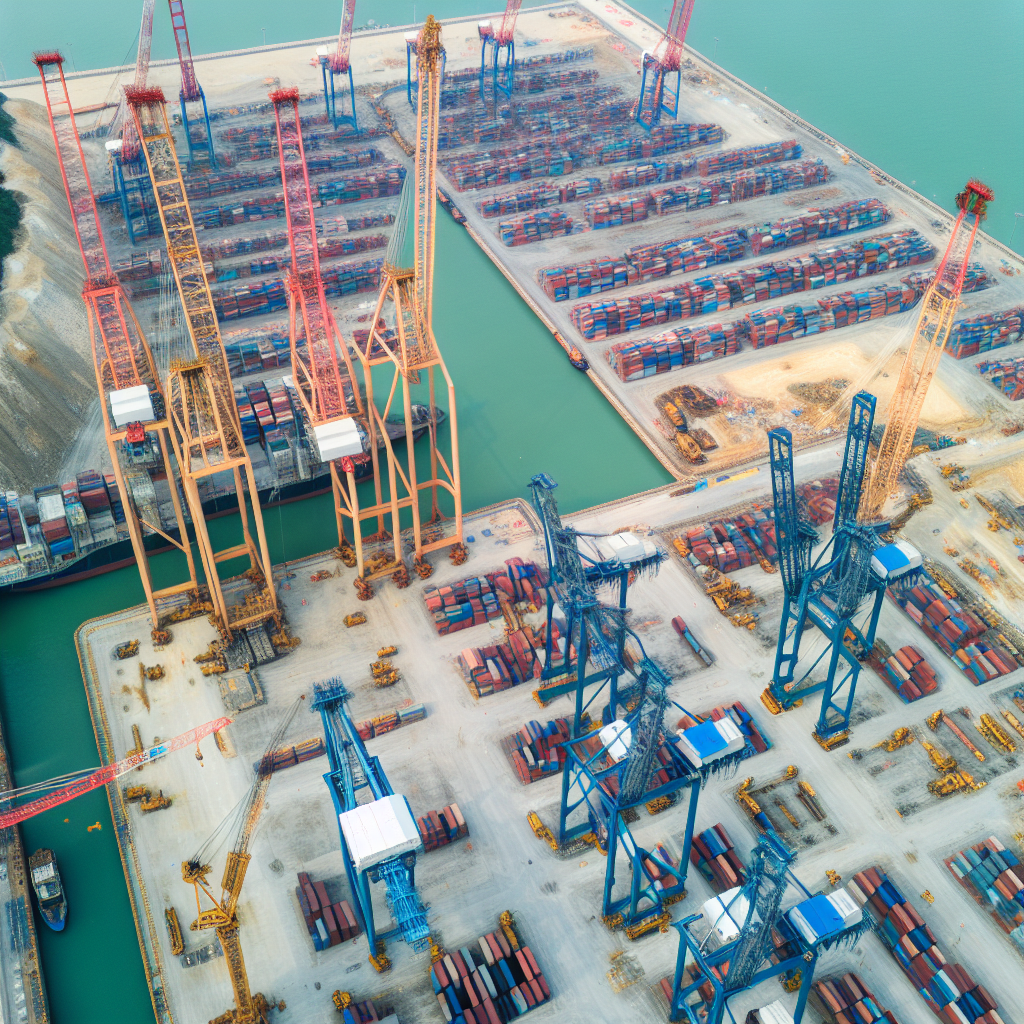
An aerial view of the Montreal Port showcasing expansion construction activities with cranes, shipping containers, and cargo ships in a vibrant and bustling port environment.
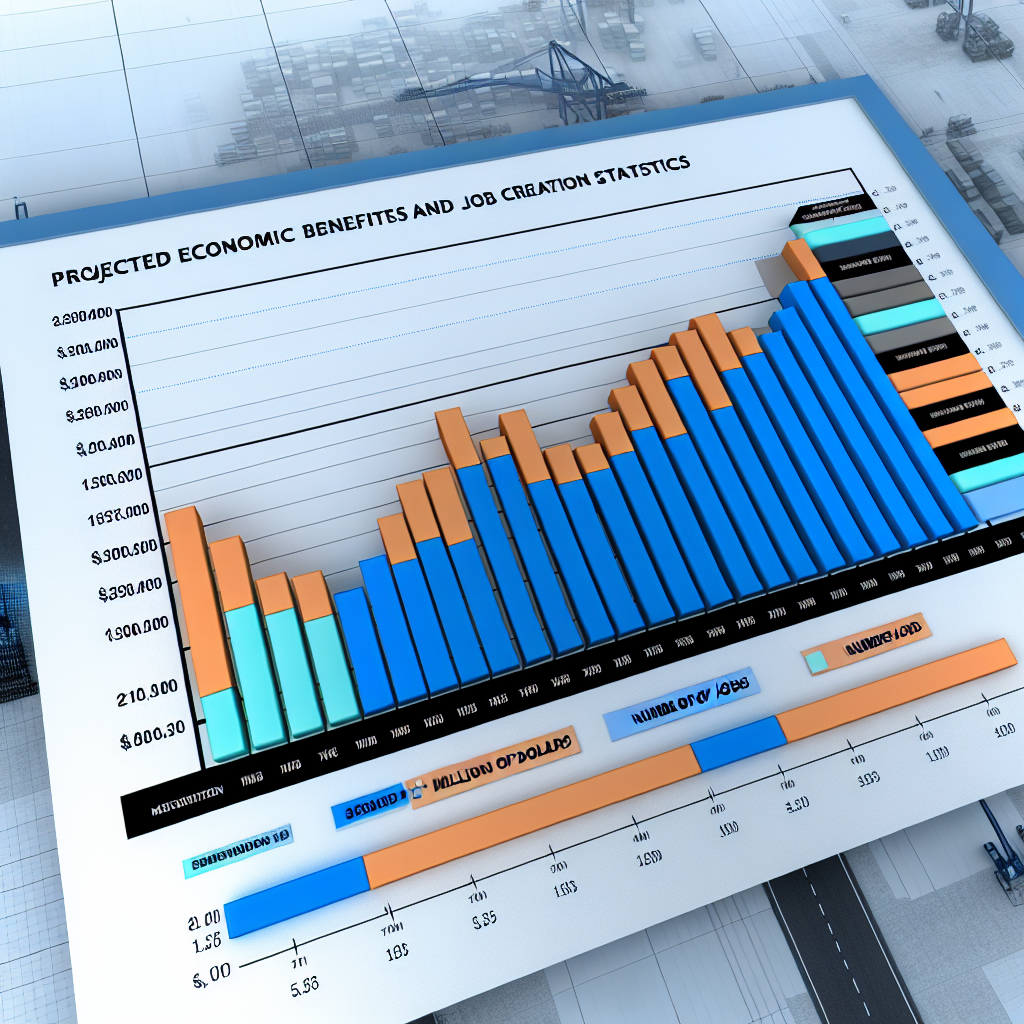
This chart illustrates the projected economic benefits and job creation from the Montreal port expansion over the next five years.
Job Creation and Community Benefits
The Montreal port expansion is not only an infrastructure project; it holds the transformative potential for local communities in Quebec and Eastern Canada through substantial job creation and community benefits.
Job Opportunities Generated
The Contrecœur container terminal, part of the Montreal port expansion, is projected to generate approximately 8,000 jobs during the construction phase and over 1,000 permanent positions once it becomes operational. These jobs will impact various sectors, notably manufacturing and distribution, as local businesses benefit from improved access to international markets and reduced transportation costs.
In 2022 alone, 3.8 million tonnes of goods linked to Ontario transited through the Port of Montreal, generating 5,181 jobs and contributing $208.1 million in tax revenues at the federal, provincial, and local levels. Overall, port operations bolstered 154,774 jobs across the Canadian economy, emphasizing the critical role the port plays in enhancing employment opportunities.
Community Engagement
In addition to economic benefits, the Montreal Port Authority (MPA) is committed to ensuring that the port expansion positively impacts local communities. The MPA plans to implement mutual benefit agreements with local municipalities to address community needs through initiatives such as improving green spaces, youth employment programs, and other community-focused investments. Julie Gascon, President and CEO of the MPA, stated:
“Our intention is clear: the development of the port in Contrecœur must have a positive impact not only on the supply chain that supports our businesses, but also on the local and regional community.”
Environmental Initiatives
The Government of Canada is also investing in Green Shipping Corridor Programs to reduce the environmental impacts of marine activities. This includes projects aimed at electrifying cargo ships and establishing shore power technology to decrease emissions, ensuring cleaner air and water for local residents while supporting job creation.
Conclusion
The expansion of the Port of Montreal is a great example of how strategic investments in infrastructure can lead to job creation while also fostering community and environmental initiatives. By prioritizing local engagement and employing sustainable practices, the project endeavors to enhance the quality of life in Quebec and Eastern Canada while simultaneously strengthening the national economy.
With such comprehensive efforts, the port not only aims to enhance economic growth but also to solidify itself as a central pillar for local communities’ future prosperity.
Implications for Supply Chains
This section will explore how the expansion of the Montreal port is poised to significantly impact supply chains. It will focus on the enhancement of overall efficiency and the diversification of trade routes that come with this critical infrastructure improvement, fostering a more robust logistical ecosystem for Eastern Canada and beyond.
Supply Chain Implications
The expansion of the Montreal port has pivotal implications for supply chains in Eastern Canada. By increasing its capacity by approximately 60%, the Port of Montreal is positioned to significantly enhance logistical efficiency across the region. This enhancement translates into the ability to manage larger volumes of goods, which not only shortens shipping times but also diversifies trade routes, making it an essential hub for both local and international trade.
Increased Capacity and Efficiency
The project is strategically designed to accommodate larger vessels, enabling the port to adapt to evolving global shipping patterns and increased demand for diverse supply sources. This capacity boost is expected to streamline operations, reduce congestion, and ultimately lead to a more responsive and agile supply chain.
As the port upgrades its infrastructure, including crucial improvements in rail capacities and containerized grain handling, these developments will allow for greater integration with national and international trade networks. Enhancing rail services allows for a greater proportion of cargo to be moved efficiently by train, which is not only economically beneficial but also environmentally sustainable.
Enhanced Trade Routes
With the expansion, the Port of Montreal will be better equipped to forge new trade routes and strengthen existing ones. By facilitating timely deliveries and optimizing logistics operations, businesses in Eastern Canada can expect closer ties with major markets in the United States, including access to over 110 million consumers within a 72-hour transit time.
Digital Infrastructure Improvements
The implementation of a new Port Community System Platform will further bolster supply chain efficiency by ensuring real-time connectivity among stakeholders. This digital infrastructure will enhance collaboration and data sharing, providing businesses and logistics providers with the tools to make informed decisions, thereby optimizing the entire supply chain process.
Conclusion
Overall, the Montreal port expansion is set to reshape the supply chain landscape in Eastern Canada, creating a more robust logistical ecosystem. The expected outcomes include not only improved trade efficiency and capacity for larger volumes of goods but also increased economic benefits for the region, characterized by enhanced job creation and regional development. As Canada positions itself as a key player in global trade, the Montreal port expansion will play a pivotal role in sustaining and growing its economic strength.
Economic Benefits vs Costs of the Montreal Port Expansion
| Economic Benefits | Estimated Costs |
|---|---|
| Annual Economic Contribution: $140 million | Total Project Cost: $1 billion |
| Jobs Created: Over 8,000 during construction | Operational Costs: Ongoing maintenance and staffing for 1,000+ jobs |
| Support for Local Economy: $93.5 billion in economic activity | Investment Risk: Potential delays and increased costs |
| Trade Volume Increase: 60% capacity expansion | Environmental Mitigation Costs: Investments in sustainability initiatives |
| Enhanced Infrastructure: Improved trade routes and logistics efficiency | Long-term Economic Viability: Requires continuous demand for expansion benefits |
| Revenue for Local Governments: Increased tax revenues | Regulatory Compliance Costs: Following environmental and safety regulations |
The table above outlines the various economic benefits projected from the Montreal port expansion against the estimated costs. This juxtaposition is crucial in assessing the overall value and impact of the expansion project on both the economy and the community.
Conclusion
The Montreal port expansion signifies a monumental leap forward for Canada’s trade operations and economic landscape. By enhancing its capacity, the port is set to drive economic growth through significant job creation, with thousands of new positions to support both construction and ongoing operations. This initiative not only emphasizes the importance of community engagement, ensuring that local benefits are prioritized, but also addresses environmental concerns through sustainable practices and habitat protections. Moreover, the project showcases Canada’s commitment to embracing infrastructure improvements that facilitate trade diversity and efficiency in logistics.
Ultimately, the Montreal port expansion positions Canada strategically for future challenges and opportunities in global trade, cementing its role as a key player in an increasingly interconnected market.
Perspectives from Key Stakeholders
As the Montreal port expansion project progresses, it has garnered attention from various stakeholders who underscore its importance for Canada’s economy and trade landscape. Below are some notable quotes that reflect the project’s significance and vision for the future:
- Mark Carney, Prime Minister of Canada:
“Export terminals and ports are projects of national interest that provide the infrastructure needed to diversify trade, open new markets, and reduce costs for Canadian businesses.” (pm.gc.ca)
- Mark Carney, Prime Minister:
“Our government is in the process of unleashing half a trillion dollars of investment in energy infrastructure, port infrastructure, particularly intelligence infrastructure, as well, with AI.” (maritimemag.com)
- Dominic LeBlanc, Minister of Intergovernmental Affairs:
“One of the reasons why this project is so important for the government of Canada is that it is a mix of private and public investment that will make a significant contribution to the GDP of the country.” (ttnews.com)
- Martin Imbleau, President and CEO of the Montreal Port Authority:
“We are developing this project not only for years to come but for decades to come.” (port-montreal.com)
- Julie Gascon, President and CEO of the Montreal Port Authority:
“This step allows us to meet the conditions required to move forward with a project that positions Quebec and Canada more strongly to diversify international trade.” (maritimemag.com)
These quotes encapsulate the strategic vision and collaborative effort surrounding the Montreal port expansion, emphasizing its potential to reshape Canada’s economic landscape and enhance its trade capabilities.
Recent Developments in Canadian Port Infrastructure and Economic Impact
- The Canadian government identifies five major infrastructure projects for expedited approval, including the Montreal port expansion, under Prime Minister Mark Carney.
- The Port of Montreal supports approximately 600,000 jobs and handles significant cargo volumes, underscoring its economic importance.
- Labor disputes highlighted the impact of port operations on economic activity, emphasizing the need for effective labor relations to sustain operations.
- The Hamilton-Oshawa Port Authority has successfully diversified cargo shipments, evidencing the significant economic activities associated with ports.
- BMO’s CEO emphasizes the importance of clarity in trade policies to attract investment in infrastructure projects, highlighting the financial sector’s role in supporting such developments.
These developments underscore the critical role of port infrastructure in Canada’s economic landscape, highlighting the importance of strategic investments and effective labor relations in sustaining and enhancing the nation’s trade capabilities.
Environmental Impacts and Mitigation Strategies
Habitat Disruption Concerns
One of the primary environmental concerns associated with the Port of Montreal’s expansion is the potential threat to the habitat of the endangered copper redhorse fish, native to Quebec. Environmental groups have voiced concerns about possible damage to the species’ feeding grounds in the St. Lawrence River. To address these concerns, the Montreal Port Authority (MPA) has put forth a variety of offsetting measures. These initiatives include:
- Creating New Fish and Bird Habitats: Establishing dedicated areas to support wildlife.
- Restoring Wetlands: Implementing restoration projects to rejuvenate existing wetlands that may be impacted.
- Monitoring Populations: Continuous assessment of the copper redhorse and other sensitive species to gauge the health of the local ecosystem. (source)
Community Engagement Initiatives
The MPA emphasizes its commitment to working with local communities through mutual benefit agreements. These agreements aim to facilitate:
- Green Space Improvements: Enhancing parks and recreational areas for community use.
- Youth Employment Programs: Targeting job creation specifically for young individuals in the region to foster community development.
The blend of economic and ecological strategies is crucial to ensuring that the project benefits both the economy and local residents. (source)
Comparative Case Studies of Port Expansions
Examinations of other ports undergoing expansions reveal various strategies to mitigate environmental impacts while fostering economic growth. Here are notable examples:
- San Pedro Bay Ports Clean Air Action Plan: This initiative led to significant reductions in air pollutants as the Ports of Los Angeles and Long Beach implemented voluntary programs, improving air quality for nearby communities. (source)
- New York/New Jersey Harbor Deepening Project: This project utilized measures that successfully prevented 2,000 tons of nitrogen oxide emissions during its development, enhancing air quality in the metropolitan area. (source)
- Port of Rotterdam’s Green Hydrogen Initiatives: With substantial investment in renewable energy, the port aims to diminish its carbon footprint through innovations like green hydrogen production. (source)
- Roberts Bank Terminal 2 Project: This ongoing evaluation project includes ecosystem modeling to assess the potential impacts on local food webs and inform mitigation strategies. (source)
- Port of Los Angeles: Shore Power Implementation: This technology allows ships to connect to the local electrical grid while docked, significantly abating emissions. (source)
Conclusion
The expansion of the Montreal port, while fostering notable economic growth, necessitates scrupulous attention to its environmental implications. Continuous dialogue with stakeholders, community engagement, and proactive mitigation measures are essential to balancing growth with ecological preservation. The ongoing efforts of the Montreal Port Authority to implement habitat protection strategies reflect a growing awareness that infrastructure projects can and should harmonize development with environmental stewardship.
Key Benefits and Impacts of the Montreal Port Expansion
- Increased Capacity: The project will expand the Port of Montreal’s capacity by approximately 60%.
- Economic Contribution: Expected to generate around $140 million annually in economic benefits.
- Job Creation: Projected creation of more than 8,000 jobs during construction and over 1,000 permanent positions.
- Enhanced Trade Efficiency: The expansion will streamline trade operations and reduce shipping times.
Job Creation Focus
- Short-Term Jobs: An estimated 8,000 jobs will be created during the construction phase, predominantly in manufacturing and logistics sectors.
- Long-Term Positions: 1,000+ permanent roles will support ongoing operations, enhancing regional employment.
- Broader Employment Impact: Through improved access to international markets, local businesses can expect growth and sustainability.
Economic Impact Overview
- Support for Local Economy: The Port significantly contributes to Quebec’s economy, supporting 589,000 jobs and generating $93.5 billion in economic activity.
- Robust Infrastructure Investment: The $1 billion Contrecœur expansion emphasizes the commitment to state-of-the-art infrastructure.
- Diversification of Trade Routes: The expansion offers a vital opportunity for diversifying trade routes with greater efficiency.
